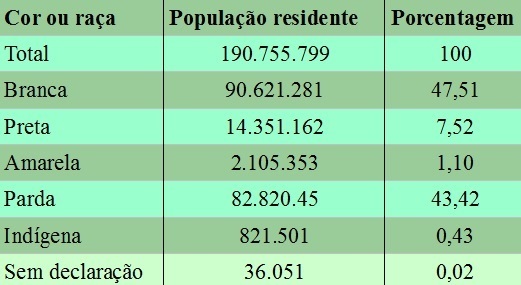Brazil, as is well known, is a country with great ethnic diversity, that is, it has a high variety of races and ethnicities. In this case, the term "race" is not understood in its biological sense, but in its sociocultural aspects of in order to differentiate population groups by external physical characteristics, usually color and others aspects. The term “ethnicity”, on the other hand, usually defines populations based also on their cultural and linguistic differences, also involving traditions, religions and other elements.
There is, therefore, an uncountable variety of types that define the ethnic composition of Brazil. For example, only indigenous, according to IBGE data, there are about 305 ethnic groups that speak more than 270 languages. This number is added to the different branches of European, African, Asian and so many peoples others who descended from the peoples who migrated to the country during its historical period post-discovery.
In general, we can say that the Brazilian ethnic composition basically comes from three major and main ethnic groups: the indigenous, the Africans and the Europeans. The Indians form the descendant groups of those who lived here before the period of discovery made by the Portuguese. With the invasion of Europeans, a good part of the indigenous groups was decimated, so that several of their ethnic groups were eradicated.
Black Africans, on the other hand, make up the group of people who were brought by force from Africa and who were enslaved here, sustaining the country's economy for several years through their work. Much of our culture, social practices, religions, traditions and customs are associated with values from these peoples. Among the African ethnic groups that came to Brazil, the Bantu, Sudanese and other populations stand out.
The European peoples who came to Brazil, on the other hand, were basically formed by Portuguese populations, in addition to groups French, Dutch, Italians, Spaniards and others, who configured the predominant ethnic matrix in the country, according to several studies.
The miscegenation of these different ethnic compositions that inhabit Brazil must also be registered. Per miscegenation it is understood the mixture of different ethnic groups, which gave rise to new populations that preserved physical and cultural traits of both their origins.
The miscegenation between whites and blacks gave rise to the people called mulattos. From the mixture between Indians and whites emerged the Mamluks, considered the first Brazilians in the period after the discovery. The miscegenation between Indians and blacks gave rise to the cafuzos.
But it is clear that this division is just a simplistic view, as it is impossible to say that only these ethnic groups make up the Brazilian population, according to the “myth of the three races” and its derivations. In fact, there are hundreds or perhaps thousands of different clusters across the territory. Brazilian, so that any classification will always restrict to a certain limit something that is much more broad.
The Brazilian Institute of Geography and Statistics (IBGE) classifies the Brazilian population based on five different types of races: whites, blacks, brown, yellow and indigenous, whose distribution can be seen in the table below, prepared based on information obtained from the Demographic Census of 2010:

Brazilian population by color or race, according to the 2010 Census
By Me. Rodolfo Alves Pena
Source: Brazil School - https://brasilescola.uol.com.br/geografia/composicao-etnica-brasileira.htm

